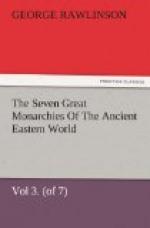Next to the camel, as a beast of burden, must be placed the mule the mules of the country are small, but finely proportioned, and carry a considerable weight. They travel thirty miles a day with ease, and are preferred for journeys on which it is necessary to cross the mountains. The ass is very inferior, and is only used by the poorer classes.
Two distinct breeds of horses are now found in Media, both of which seem to be foreign—the Turkoman and the Arabian. The Turkoman is a large, powerful, enduring animal, with long legs, a light body, and a big head. The Arab is much smaller, but perfectly shaped, and sometimes not greatly inferior to the very best produce of Nejd. A third breed is obtained by an intermixture of those two, which is called the bid-pai, or “wind footed,” and is the most prized of all.
The dogs are of various breeds, but the most esteemed is a large kind of gray hound, which some suppose to have been introduced into this part of Asia by the Macedonians, and which is chiefly employed in the chase of the antelope. The animal is about the height of a full sized English grayhound, but rather stouter; he is deep-chested, has long, smooth hair, and the tail considerably feathered. His pace is inferior to that of our grayhounds, but in strength and sagacity he far surpasses them.
We do not find many of the products of Media celebrated by ancient writers. Of its animals, those which had the highest reputation were its horses, distinguished into two breeds, an ordinary kind, of which Media produced annually many thousands, and a kind of rare size and excellence, known under the name of Nisaean. These last are celebrated by Herodotus, Strabo, Arrian, Ammianus Marcellinus, Suidas, and others. They are said to have been of a peculiar shape; and they were equally famous for size, speed, and stoutness. Strabo remarks that they resemble the horses known in his own time as Parthian; and this observation seems distinctly to connect them with the Turkoman breed mentioned above, which is derived exactly from the old Parthian country. In color they were often, if not always, white. We have no representation on the monuments which we can regard as certainly intended for a Nissean horse, but perhaps the figure from Persepolis may be a Persian sketch of the animal. [PLATE III., Fig. 4.]
The mules and small cattle (sheep and goats) were in sufficient repute to be required, together with horses, in the annual tribute paid to the Persian king.
Of vegetable products assigned to Media by ancient writers, the most remarkable is the “Median apple,” or citron. Pliny says it was the sole tree for which Media was famous, and that it would only grow there and in Persia. Theophrastus, Dioscorides, Virgil, and other writers, celebrate its wonderful qualities, distinctly assigning it to the same region. The citron, however, will not grow in the country which has been here termed Media. It flourishes only in the warm tract between Shiraz and the Persian Gulf, and in the low sheltered region, south of the Caspian, the modern Ghilan and Mazanderan. No doubt it was the inclusion of this latter region within the limits of Media by many of the later geographers that gave to this product of the Caspian country an appellation which is really a misnomer.




